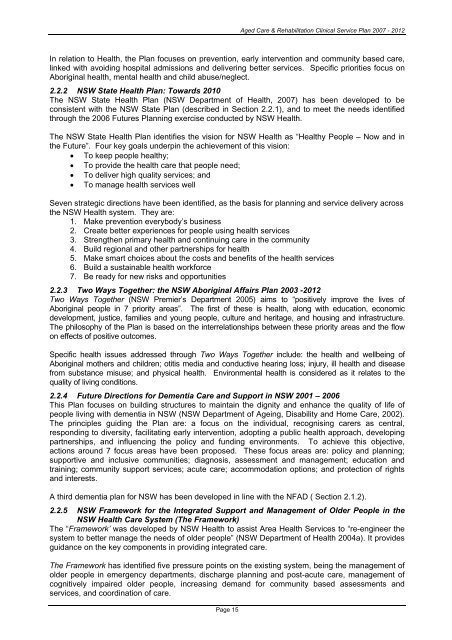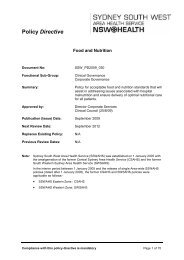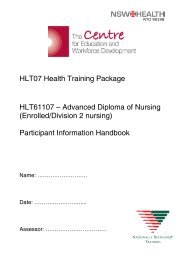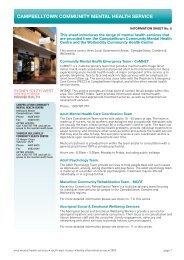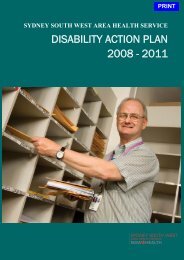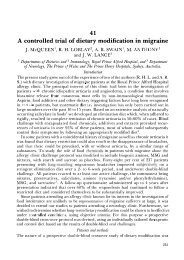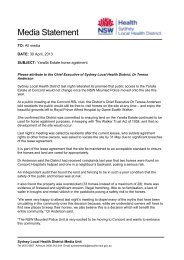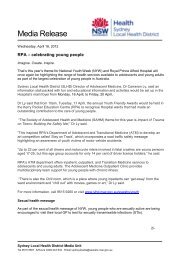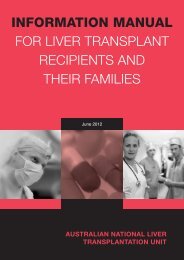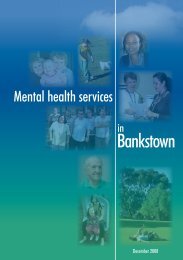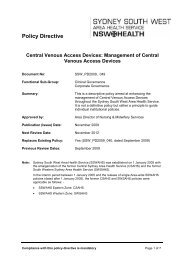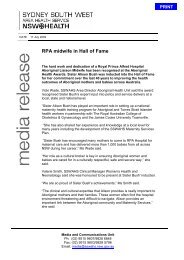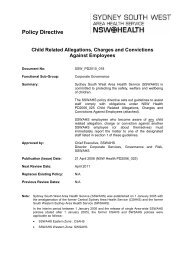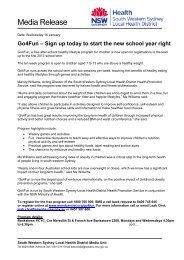Aged Care & Rehabilitation Clinical Services Plan 2007 – 2012
Aged Care & Rehabilitation Clinical Services Plan 2007 – 2012
Aged Care & Rehabilitation Clinical Services Plan 2007 – 2012
Create successful ePaper yourself
Turn your PDF publications into a flip-book with our unique Google optimized e-Paper software.
<strong>Aged</strong> <strong>Care</strong> & <strong>Rehabilitation</strong> <strong>Clinical</strong> Service <strong>Plan</strong> <strong>2007</strong> - <strong>2012</strong>In relation to Health, the <strong>Plan</strong> focuses on prevention, early intervention and community based care,linked with avoiding hospital admissions and delivering better services. Specific priorities focus onAboriginal health, mental health and child abuse/neglect.2.2.2 NSW State Health <strong>Plan</strong>: Towards 2010The NSW State Health <strong>Plan</strong> (NSW Department of Health, <strong>2007</strong>) has been developed to beconsistent with the NSW State <strong>Plan</strong> (described in Section 2.2.1), and to meet the needs identifiedthrough the 2006 Futures <strong>Plan</strong>ning exercise conducted by NSW Health.The NSW State Health <strong>Plan</strong> identifies the vision for NSW Health as “Healthy People – Now and inthe Future”. Four key goals underpin the achievement of this vision:• To keep people healthy;• To provide the health care that people need;• To deliver high quality services; and• To manage health services wellSeven strategic directions have been identified, as the basis for planning and service delivery acrossthe NSW Health system. They are:1. Make prevention everybody’s business2. Create better experiences for people using health services3. Strengthen primary health and continuing care in the community4. Build regional and other partnerships for health5. Make smart choices about the costs and benefits of the health services6. Build a sustainable health workforce7. Be ready for new risks and opportunities2.2.3 Two Ways Together: the NSW Aboriginal Affairs <strong>Plan</strong> 2003 -<strong>2012</strong>Two Ways Together (NSW Premier’s Department 2005) aims to “positively improve the lives ofAboriginal people in 7 priority areas”. The first of these is health, along with education, economicdevelopment, justice, families and young people, culture and heritage, and housing and infrastructure.The philosophy of the <strong>Plan</strong> is based on the interrelationships between these priority areas and the flowon effects of positive outcomes.Specific health issues addressed through Two Ways Together include: the health and wellbeing ofAboriginal mothers and children; otitis media and conductive hearing loss; injury, ill health and diseasefrom substance misuse; and physical health. Environmental health is considered as it relates to thequality of living conditions.2.2.4 Future Directions for Dementia <strong>Care</strong> and Support in NSW 2001 – 2006This <strong>Plan</strong> focuses on building structures to maintain the dignity and enhance the quality of life ofpeople living with dementia in NSW (NSW Department of Ageing, Disability and Home <strong>Care</strong>, 2002).The principles guiding the <strong>Plan</strong> are: a focus on the individual, recognising carers as central,responding to diversity, facilitating early intervention, adopting a public health approach, developingpartnerships, and influencing the policy and funding environments. To achieve this objective,actions around 7 focus areas have been proposed. These focus areas are: policy and planning;supportive and inclusive communities; diagnosis, assessment and management; education andtraining; community support services; acute care; accommodation options; and protection of rightsand interests.A third dementia plan for NSW has been developed in line with the NFAD ( Section 2.1.2).2.2.5 NSW Framework for the Integrated Support and Management of Older People in theNSW Health <strong>Care</strong> System (The Framework)The “Framework’ was developed by NSW Health to assist Area Health <strong>Services</strong> to “re-engineer thesystem to better manage the needs of older people” (NSW Department of Health 2004a). It providesguidance on the key components in providing integrated care.The Framework has identified five pressure points on the existing system, being the management ofolder people in emergency departments, discharge planning and post-acute care, management ofcognitively impaired older people, increasing demand for community based assessments andservices, and coordination of care.Page 15


